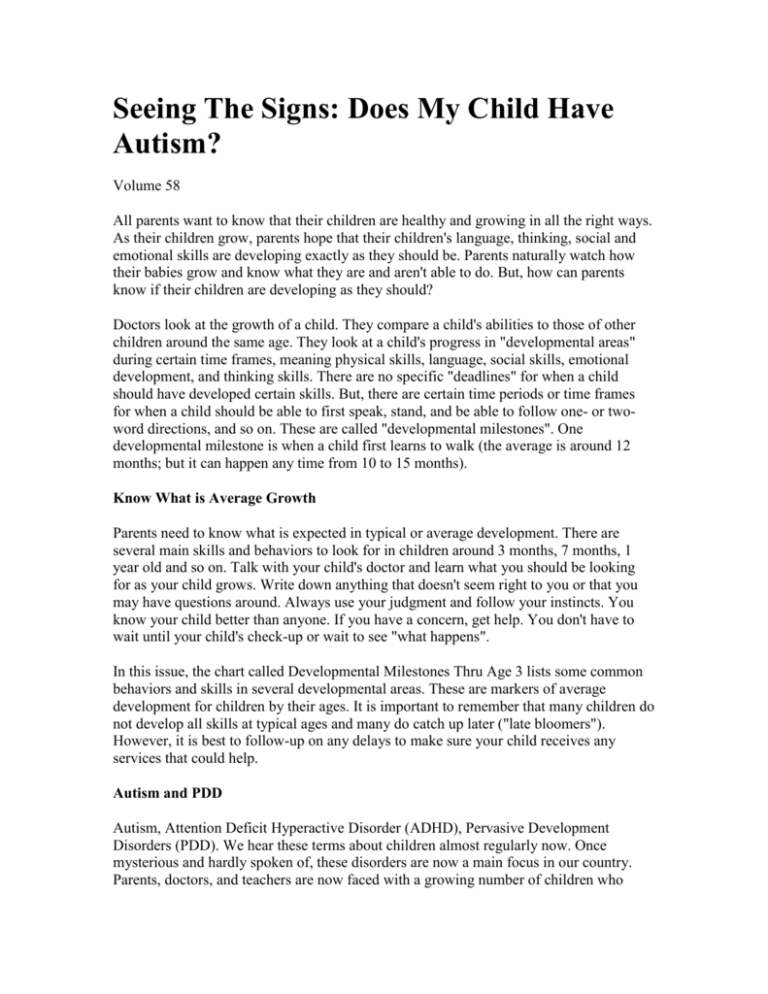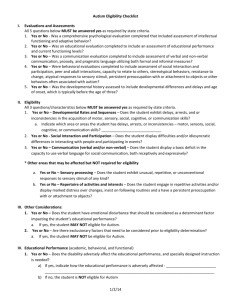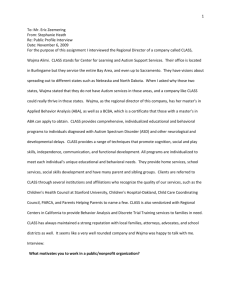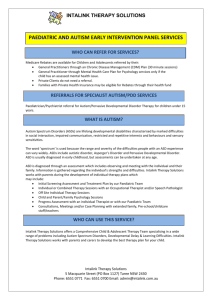
Seeing The Signs: Does My Child Have
Autism?
Volume 58
All parents want to know that their children are healthy and growing in all the right ways.
As their children grow, parents hope that their children's language, thinking, social and
emotional skills are developing exactly as they should be. Parents naturally watch how
their babies grow and know what they are and aren't able to do. But, how can parents
know if their children are developing as they should?
Doctors look at the growth of a child. They compare a child's abilities to those of other
children around the same age. They look at a child's progress in "developmental areas"
during certain time frames, meaning physical skills, language, social skills, emotional
development, and thinking skills. There are no specific "deadlines" for when a child
should have developed certain skills. But, there are certain time periods or time frames
for when a child should be able to first speak, stand, and be able to follow one- or twoword directions, and so on. These are called "developmental milestones". One
developmental milestone is when a child first learns to walk (the average is around 12
months; but it can happen any time from 10 to 15 months).
Know What is Average Growth
Parents need to know what is expected in typical or average development. There are
several main skills and behaviors to look for in children around 3 months, 7 months, 1
year old and so on. Talk with your child's doctor and learn what you should be looking
for as your child grows. Write down anything that doesn't seem right to you or that you
may have questions around. Always use your judgment and follow your instincts. You
know your child better than anyone. If you have a concern, get help. You don't have to
wait until your child's check-up or wait to see "what happens".
In this issue, the chart called Developmental Milestones Thru Age 3 lists some common
behaviors and skills in several developmental areas. These are markers of average
development for children by their ages. It is important to remember that many children do
not develop all skills at typical ages and many do catch up later ("late bloomers").
However, it is best to follow-up on any delays to make sure your child receives any
services that could help.
Autism and PDD
Autism, Attention Deficit Hyperactive Disorder (ADHD), Pervasive Development
Disorders (PDD). We hear these terms about children almost regularly now. Once
mysterious and hardly spoken of, these disorders are now a main focus in our country.
Parents, doctors, and teachers are now faced with a growing number of children who
have autism, ADHD, PDD and other similar disorders. Some have even called it an
"epidemic". If you are a parent hearing one of these "labels" associated with your child, it
can be frightening. It is easy to become overwhelmed and unsure about what to do next
and how it will affect your child.
So what are these disorders? What does it mean for your child? Autism is a word that
covers delays or something that is unusual in a child's development in more than one
developmental area. This means there is a delay of some sort in the areas of:
communication/language, social interaction, and behavior. "Pervasive" means there are
delays across many areas in a child's development, not just one.
These kinds of delays are almost always noticeable by the age of 3. Children do not
become autistic or have PDD later in life. Autism or PDD can be detected and treated as
early as 18 months. For instance, a child may be delayed in his speech, have a lot of
difficulty with fine motor skills, and be behind in social skills, and that would be
considered in the PDD category. The difference between Autism and PDD is usually in
how severe the delays or abnormalities are in a child's abilities, and how a child functions
on an everyday basis.
There are many other kinds of disorders that have similar signs as Autism. Many children
have mixed symptoms or may have more than one condition (for example many children
with PDD usually have learning disabilities, and may also have speech delays). So
getting a full evaluation and proper diagnosis from your doctor is critical. That way, you
can get the services that will treat the symptoms your child has, rather than just guessing
what the disorder may be.
Signs of Delays or a Disorder
There are some general signs that may mean your child has a delay in development, or
has a more specific developmental disorder such as Autism or PDD.
While knowing and observing the typical developmental milestones with your child, also
take note if your child displays any of the following signs associated with the possibility
of having PDD or Autism.
Social and Communication
Your child's speech is not at the level it should be for your child's age; or your
child stops saying words they use to know or has a reverse in speech skills
Your child's speech has unusual patterns, such as your child repeats phrases over
and over, or only repeats what is said on TV or videos
Your child's voice has a high pitch tone or is flat in pitch with no change
Your child does not point at objects to show interest
Your child has trouble expressing what she needs with words or gestures
Behavior/Personality
Your child does not have eye contact when talking with you or others
Your child prefers to be alone and play alone
Your child does not like being held or cuddled
Your child does not seem to be interested in other people
Your child has many and unusually long temper tantrums
Your child repeats certain actions over and over (hand gestures, movements)
Your child has unusual interests (lining up objects, spinning objects)
Your child has trouble adjusting to changes in routine
Sensory and Motor
Your child is very sensitive to sounds, the way things feel, taste or look (may
react very strongly to them)
Your child likes being squeezed or hugged very tightly
Your child runs or bumps into things a lot; is considered "clumsy"
Your child has trouble with small motor skills such as grasping objects or holding
crayons or utensils
Physical
Your child does not crawl, walk or talk at any of the expected age ranges
Your child's vision or hearing does not seem normal
Your child walks on his toes all the time
Note: These signs only show a possible delay if you see then regularly. Parents,
caregivers and other adults who spend a lot of time with children are often the best
observers. They can often pick up on behaviors that a doctor may not in a few minutes
with a child. A child with any disorder may not show all of associated behaviors or signs.
In fact, most will not, because all children are unique.
Where to Get Help
Parents should always start with their child's doctor when they have concerns about their
child. Doctors will always want to run tests to rule out any medical causes for symptoms.
Your child's doctor can also direct you to specialists to do a complete developmental
evaluation. The doctor can also help you get other specialized services if needed. Every
state has a "Child Find" program (which could be under a different name) that is operated
under the state's Department of Social Services (for children under age 3) and
Department of Education (for children 3 and older). If you think your child has
developmental delays, you can get a free evaluation for your child. Depending on the
outcome of the evaluation, your child may be eligible for free services.
Although it can be overwhelming to find out that your child has delays or a
developmental disorder, a diagnosis of Autism or PDD (or any other disorder) does not
define your child and his abilities for the rest of his life. Research has shown that the
earlier the intervention and any services are started for developmental delays, the better
results for children in the long run. Give your child the best start in life. Talk to your
child's doctor if you see the signs.
Developmental Milestones Thru Age 3-By Area and What You Should See Your Child Doin
By the end of 3
By the end of 7
Developmental Areas
By the end of 1 year By the end of
months
months
Begins to
smile
Enjoys playing
with others
and may cry
when playing
stops
Is more
expressive;
communicates
more with face
and body
Imitates some
movements
and facial
expressions
Enjoys social
play
Likes seeing
himself in
mirror
Responds to
other
people's
expressions
of emotion
and appears
happy often
Social/Emotional
Shy or
anxious with
strangers
Cries when
mother or
father leaves
Enjoys
imitating
people in his
play
Shows
specific
preferences
for certain
people and
toys
Tests
parents'
responses to
his actions
during
feedings
Tests
parents'
responses to
his behavior
May be
fearful in
some
situations
Prefers
mother
and/or
regular
caregiver
over all
others
Repeats
sounds or
Imitate
of othe
especi
and ol
childre
More a
herself
separa
others
More e
about
of othe
Demo
increas
indepe
Begins
defian
Separa
anxiet
toward
then fa
Physical/Movement
Raises head
and chest
when lying on
stomach
Supports upper
body with
arms when
lying on
stomach
Stretches legs
out and kicks
when lying on
stomach or
back
Pushes down
on legs when
feet are placed
on a firm
surface
Rolls both
ways (front
to back, back
to front)
Sits with,
and then
without,
support on
hands
Supports
whole
weight on
legs
gestures for
attention
Finger-feeds
himself
Extends arm
or leg to help
when being
dressed
Reaches
sitting
position
without any
help
Crawls
forward on
belly
Can do
hands-andknees
position
Creeps on
hands and
knees
Gets from
sitting to
crawling or
prone (lying
on stomach)
position
Pulls self up
to stand
Walks
holding on to
things
Stands
momentarily
without
support
May walk
two or three
steps without
support
Walks
Pulls t
her wh
walkin
Carrie
or seve
while
Begins
Stands
Kicks
Climb
down
furnitu
help
Walks
down
holdin
suppor
Does not apply
Language/Communication
Responds to
own name
Begins to
respond to
"no"
Can tell
emotions by
tone of voice
Responds to
sound by
making
sounds
Uses voice to
express
happiness
and
unhappiness
Babbles alot
of sounds
Hand and Finger Skills
(Small Motor)
Opens and
shuts hands
Brings hand to
mouth
Swipes at
dangling
objects with
hands
Grasps and
shakes hand
toys
Reaches with
one hand
Moves
object from
hand to hand
Uses hand to
rake objects
Pays more
attention to
speech
Responds to
simple
verbal
requests
Responds to
"no"
Uses simple
gestures,
such as
shaking head
for "no"
Babbles with
voice
(changes in
tone)
Says "dada"
and "mama"
Uses
exclamations
, such as
"Oh-oh!"
Tries to
imitate
words
Uses pincer
grasp (thumb
and index
finger)
Bangs two
objects
together
Puts objects
into
container
Takes
objects out
of container
Lets objects
go
voluntarily
Pokes with
Points
or pict
it's nam
Recog
names
familia
object
body p
Says s
single
15 to 1
Uses s
phrase
24 mo
Uses 2
word s
Follow
instruc
Repea
overhe
conver
Does n
action
by the
period
Can sc
Turns
contai
out co
Builds
four bl
more
Might
hand m
than th
Vision
Hearing/Speech
Watches faces
intently
Follows
moving
objects
Recognizes
familiar
objects and
people at a
distance
Starts using
hands and eyes
in coordination
index finger
Tries to
imitate
scribbling
Develops
full color
vision
Distance
vision
matures
Ability to
track moving
objects
improves
Vision fully
developed at
this point
Smiles at the
sound of your
voice
Begins to
babble
Begins to
imitate some
sounds
Turns head
toward
direction of
sound
Hearing and
speech
capacity fully
developed by
this time (not
the same as
Cognitive/Thinking Skills
Finds
partially
hidden
object
Explores
with hands
and mouth
Explores
objects in
different
ways
(shaking,
banging,
throwing,
Finds
hidden
or thre
Begins
shapes
colors
Begins
Struggles to
get objects
that are out
of reach
dropping)
Finds hidden
objects
easily
Looks at
correct
picture when
the image is
named
Imitates
gestures
Begins to use
objects
correctly
(drinking
from cup,
brushing
hair)
(from the CDC's website, Learn The Signs/Act Early, Interactive Tools for Parents:
Milestones Chart. The CDC's interactive tool and milestones chart goes through age 6.
We have included through age 3 here since most atypical symptoms occur before this
age.).
For More Information
Learn the Signs, Act Early Campaign is a partnership campaign (under the
Centers for Disease Control's National Center on Birth Defects and
Developmental Disabilities Office) to inform and educate parents, child care
providers, physicians and other adults in young children's lives on the early signs
of possible developmental delays - with a focus on delays other than physical
growth. Bringing to light the often overlooked symptoms in very young children
that could be linked to Autism or other developmental disorders, this website has
a lot of information that parents can use throughout their child's early
development. Highlights: interactive online development tool, fact sheets, free
campaign materials for professionals.
Autism Society of America is a national membership organization for parents,
families and other concerned individuals that serves as a support and advocacy
system for children and adults with autism. The website provides research on
autism and has a resource section where parents and family members can find out
where their local chapter is located.
believ
The Daily Parent is prepared by NACCRRA, the National Association of Child Care
Resource and Referral Agencies, with funding from the Citi Foundation. © 2009
NACCRRA. All rights reserved.
Retrieved 4/14/09 at
http://www.childcareaware.org/en/subscriptions/dailyparent/volume.php?id=58









